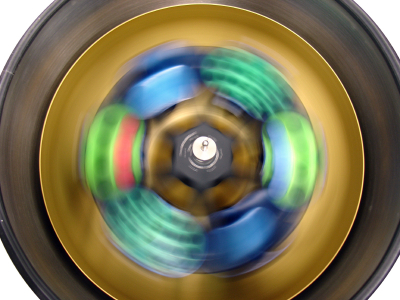
My husband likes to cook and he also likes to collect kitchen gadgets. Mushroom slicers, blenders, numerous graduated vials and measuring devices, meat thermometers, etc., our kitchen drawers are overflowing with the essentials for precision cooking. For each culinary process, there is a unique device, and he uses them all. I do not even know what some of them are for. I only use knives and measuring cups. But his cooking is way better than mine so there is obviously some benefit to using the right tools well.
Some of the most sophisticated kitchen tools come straight from the laboratory. I was interested to read an article in the March 2011 issue of Scientific American describing how high-speed centrifuges are among the newest trends in fancy kitchen equipment. They are being used in restaurants to separate ingredients into their component parts and create potent flavorings. It turns out that centrifugation is a fast and convenient way to purify fat from various vegetables and nuts, creating interesting flavored butters and dairy-free creams (think pea butter or essence of carrot). Centrifugation is a fast alternative to straining or filtering as a means of separating components.
It can also be used to create highly flavorful water and oil layers that can add intense flavors to clear soups and other dishes, and to quickly separate fats. Intensifying flavor and removing fat—it seems that centrifugation has a lot to offer as a tool for the adventurous cook. I don’t know if I have room for one in my kitchen though!
Of course the high-speed centrifuge is not the first piece of lab equipment to transition to the kitchen. The autoclave made that move years ago in the form of the pressure cooker. Home canning springs to mind as one kitchen chore made much easier by the availability of the household equivalent of the autoclave. My mum embraced pressure cooking enthusiastically for a while. Why spend hours slaving over a meal when you can put it all into a pan and cook it under pressure for 15 minutes instead? The answer, it turns out, is FLAVOR. From that experience our family came to the opinion that autoclaved food is best avoided. (Just say “Irish Stew” to any member of my family and watch their reaction). Apparently consommé and soups are a different matter, and it turns out that the autoclave is a useful tool for creating these.
The other piece of lab equipment that is now on its way to the home kitchen is the immersion water bath. Because they enable very tight control of temperature, these are used for sous vide cooking—a method where the food is sealed in a plastic bag and immersed in a water bath at a constant, low temperature for a long time (otherwise known as “molecular gastronomy”). For a while, cooks who wanted one of these had to buy lab equipment, and so they were mainly confined to the realm of restaurants and TV cooking shows. But recently versions of the immersion water bath designed (and priced) for home use have become available.
Cooking is science after all so it is perhaps not surprising to see certain pieces of lab equipment transitioning from the lab to the kitchen.
Further Reading on Cooking with Scientific Equipment
Scientific American Article: A New Spin on Cooking
The Precision Water Bath for Cooks

Hi Isobel,
I can’t tell you how many times I have raised eyebrows because I take the time to see where the bottom of the meniscus is when I am measuring liquids in the kitchen. Don’t know that it improves my cooking though…
Michele
Hi Isobel,
The food item in the lab that always got a laugh out of me was when I pulled open a drawer to find a Seal-a-Meal machine and accompanying bags. And don’t forget Pyrex dishes: found in good laboratories and kitchens everywhere!
Sara
My sister, PharmD, is a master at compounding. She uses these skills when mixing cookie dough and her cookies are so delicious!
On the flip side, Salad Spinners make excellent low-budget centrifuges :)
I have experimented a time or two with my Cole Parmer centrifugal pump in the kitchen, too!